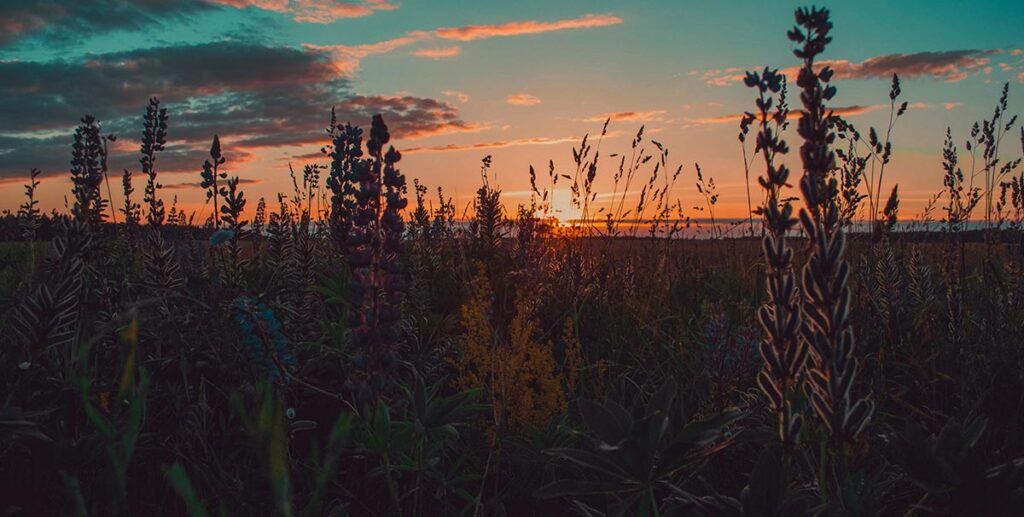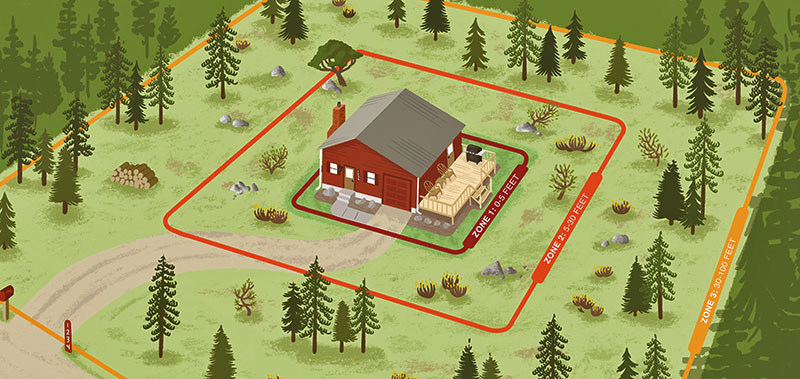Fact Sheet 6.305 | Wildfire Mitigation Series, Landscaping and Planting
By S. Carter, N. Goeckner, C. Julian (CSFS), L. Langelo, I. Shonle, and C. Dennis (Emeritus
CSFS) (4/23).
Quick Facts
- The right plants around structures are important for wildfire safety
- Management of defensible space and plant types are essential
- This factsheet is a series of three
- Plants rated 10 have the least flammability
- This factsheet recommends low flammability plants for Zone 1 and 2
- Refer to the CSFS-HIZ2021 Guide for further details on HIZ zones
Introduction
In Colorado, in the wildland-urban interface, it is not a matter of if a wildfire will impact residences and properties, but when. This includes any areas where structures and other human developments meet or intermingle with wildland vegetative fuels, including grasses, shrubs, and trees. Wildfires are a natural part of Colorado’s varied ecosystems. Planning ahead and taking action to reduce the risk of wildfires can increase the likelihood a home survives when wildfires occur. Firefighters always do their best to protect residents, but ultimately, it is your responsibility to protect your property and investments from wildfire.
This factsheet is a part of a series of three publications that can help homeowners focus on actions that are effective in reducing wildfire hazards on properties. It is important to recognize that these efforts should always begin with the home or structure itself and progress outwards. Defensible space is the area around a home or other structures that has been modified to reduce fire hazards by creating a disconnected fuel load both vertically and horizontally.
In this area, natural and manmade fuels are treated, removed or reduced to slow the spread of wildfire and alter fire behavior. Plants that are low flammability are selected for planting, especially closer to the home. Creating an effective defensible space involves establishing a series of management zones. Develop these zones around each building, including detached garages, storage buildings, barns and other structures. Recognize that fuel continuity and density play a critical role in wildfire behavior.
Zones are defined from the structure edge in feet:
- Zone 1: 0-5 feet
- Zone 2: 5-30 feet
- Zone 3: 30-100 feet
This fact sheet will cover plants in zones 1 and 2, the Fire-Resistant Landscaping fact sheet will cover plants as they relate to zone 3. For a defensible space plan for properties, contact either the nearest CSFS field office or local CSU-Extension office for guidance. Consult with a forester, fire department staff or community organization appropriately trained in wildfire mitigation practices.
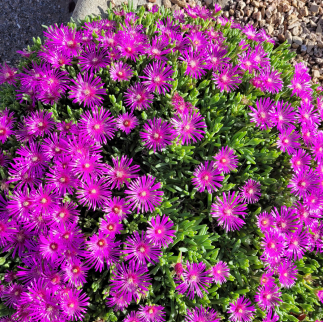
Pictured: Purple Ice Plant (Photo by S. Carter)
Low-Flammability Plant Characteristics
This fact sheet replaces Firewise Plant Materials (6.303). Recommendations on this list are based on a methodology developed by Idaho Firewise in Boise, Idaho. A link to their site is provided in the supporting publications section. The methodology rates the flammability of plants based on the characteristics in the boxes below based on a scale of 0-10 with 0 the most flammable and 10 the least flammable. To create the highest degree of protection for structures, the recommendation is to plant only plants with scores of 8, 9 and 10 for zones 1 and 2 within the first 30’ from the home. These species are the least flammable plants to plant near structures, but keep in mind that there are no truly “fireproof” plant species. Existing vegetation with scores below an 8 (indicating more flammability), is addressed in the Fire-Resistant Landscaping fact sheet (6.303).
View the PDF Fact Sheet to review tables of low-water flowers, groundcover plants, shrubs, trees, cacti, and grasses.
Plants that have lower flammability and are more resistant to wildfire and plants that have a higher flammability and are less resistant to wildfire have the specific characteristics below:
Attributes that decrease flammability
- Low oil or resin content
- High moisture content
- Soap, latex or pectin content
- Compact growth form
- Green stems
- Drought tolerant
Attributes that increase flammability
- High oil or resin content
- Low moisture content
- Tall growth
- Open form
- Fine wood (twiggy) stems
- High water need
Many plants are highly flammable during different seasons of the year. At such times, left unmanaged, they can accelerate the spread of a wildfire through your neighborhood, threatening homes, property and lives. All vegetation, naturally occurring and otherwise, is potential fuel for fire. Its type, amount and arrangement have a dramatic effect on fire behavior.
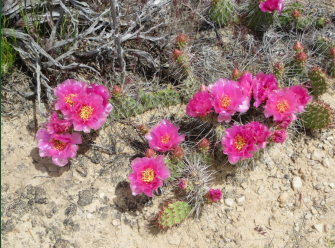
Pictured: Opuntia (Photo by I. Shonle)
There are no “fireproof ” plant species. Plant choice, spacing and maintenance are critical to defensible space landscaping.
There are many concept to keep in mind when choosing low-flammability plants. A plant’s moisture content is the single most important factor governing its volatility. However, resin content and other factors in some species render them flammable even when the plant is well-watered. Conifers tend to be flammable due to their oil and pitch content, regardless of their water content. Deciduous plants tend to be more fire resistant because their leaves have higher moisture content and their basic chemistry is less flammable. Also, when deciduous trees are dormant, there is less fuel to carry fire through their canopies.
In some cases, there is a strong correlation between drought tolerance and fire resistance. These plants offer less fuel or have a higher moisture content, both of which help reduce fire hazard. There also appears to be a correlation between a plant’s salt tolerance and natural fire resistance. Plants adapted to salty conditions, and actually growing in salty situations, may better resist burning.
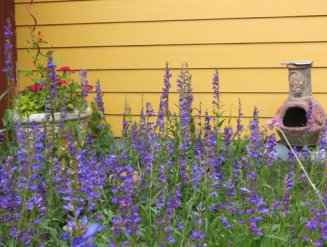
Pictured: Rocky Mountain Penstemon (Photo by I. Shonle)
Most of our native vegetation is adapted to fire and is flammable. Common flammable plants have flammability scores less than 8. Common flammable trees are junipers, pines, firs, and spruces. Common flammable shrubs are gambel oak, three-leaf sumac and mountain mahogany. We would discourage planting these species adjacent to the home in defensible space zones 1 and 2.
If they are already present, consider replacing them with some of the recommended species listed here. If you decide to keep a flammable plant in your landscape, keep it pruned and thinned, remove dead material regularly, and keep it at least 30 feet from any structure or other plants. These mitigation measures will be described in further detail in the Fire Resistant Landscaping Publication (6.303).

- Plants with HIGHER scores means low flammability
- Plants with LOWER scores means high flammability
Don’t Forget Maintenance
A landscape is a dynamic, constantly changing system. Plants considered “fire resistant” and that have low amounts of flammable vegetation can lose these characteristics over time. Your landscape, and the plants in it, must be maintained to retain their low flammability properties. Maintenance will be addressed in further detail in the Fire Resistant Landscaping Publication (6.303).
Supporting Publications from CSU Extension, CSFS, and Idaho Firewise
The following publications are available and are referenced. The CSFS Home Ignition Zone Guide
describes the concepts of structural ignitability and defensible space. Low-Flammability Landscape Plants 6.305 recommends fire-resistant plants for zones 1 and 2 identified in the defensible space section of the CSFS HIZ Guide. Fire-Resistant Landscaping recommends design features for zones 1, 2 and 3 and recommends plants with mitigation measure for plants and existing vegetation in zone 3. The CSFS HIZ Guide, Low Flammability Landscape Plants and Fire Resistant Landscaping are considered a package that can help with develop actions to reduce wildfire risk and impacts. The Idaho materials provided the basis for the addition of our flammability scoring and approach for this update.
- CSFS Home Ignition Guide, 2021 (Replaces 6.302, Creating Wildfire-Defensible Zones)
- CSFS Fire-Resistant Landscaping Guide
- Idaho Firewise, Fire-Resistant Landscapes – Plant Materials
View the PDF Fact Sheet to access tables and additional information.
Colorado State University Extension is an equal opportunity provider. | Colorado State University Extension es un proveedor que ofrece igualdad de oportunidades.


